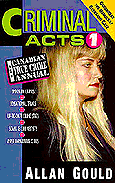


|
Criminal acts 1: the Canadian true crime annual.
Allan Gould.
Grades 10 - 13 / Ages 14 and Up.
|
excerpt:
Vancouver, JanuaryUGLY VIOLENCE IN VANCOUVER
It was all a set-up. Parminder Chana got a phone call in his car at 9:00 p.m. from a friend, saying he had to see the man right away, and they should meet at the Insurance Corporation of British Columbia salvage yard in New Westminster, where the twenty-one-year-old worked as a night security guard.
When Chana got to the yard, he was wrestled to the ground and stabbed, and the following morning his body was found floating in a ditch nearby. His throat slit, his fingers amputated and his body stabbed fifty-three times.
Four days later, Chana's seventeen-year-old girlfriend, Jassy Benji, jumped to her death from the Pattullo Bridge, leaving a suicide note that read: ``When Parmar died, I died."
In the trial, the court learned that Jassy's brother, Rajinder, had killed Chana because he frowned on his sister dating the man. Faisel Ali Dean was convicted of second-degree murder after his girlfriend admitted that he had bragged to her about holding Chana down while Rajinder Benji stabbed him. Faisel was expected to be sentenced in February.
Gould has set himself the task ``to try to capture a year of Crime and Justice in Canada." This is a large job that could provide a valuable source of information for both interested readers and students studying a wide range of related topics.
Not recommended.
Neil V. Payne is a teacher-librarian at Kingston Collegiate in Kingston Ontario.
To comment on this title or this review, send mail to cmeditor@mts.net
![]()
Copyright © 1996 the Manitoba Library Association.
Reproduction for personal use is permitted only if this copyright notice
is maintained. Any other reproduction is prohibited without permission.
Published by
The Manitoba Library Association
ISSN 1201-9364
 Go back to CM Welcome page
Go back to CM Welcome page
 Go back to Table of Contents for this Issue
Go back to Table of Contents for this Issue